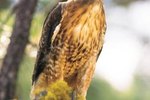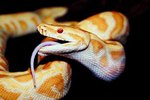Birds are diverse and have a variety of different adaptations. Some have evolved to be flightless, others have evolved to swim. Some birds are predatory, others scavenge. Their senses have adapted along with their anatomies. There is no such thing as a weaker sense in the avian world, because birds use their senses in different ways, depending on how they’ve evolved.
No Need for a Nose
Because the majority of birds fly and spend much of their lives in trees, their sense of smell is typically the least sophisticated. By the time a scent has traveled high enough for a bird in flight to detect it, the scent particles will have dissipated, meaning there is nothing left to smell. Before they evolved wings to fly, birds used their olfactory sense much more than they do now. However, some ground-dwelling birds never lost that keen nose. Kiwis, for example, are capable of detecting earthworms using just their sense of smell.
Eagle-Eyed Hunters
Birds typically are associated with great eyesight. We even use the avian metaphor “eagle-eyed” to describe a person with keen eyesight. This theory holds true for the majority of birds, with owls, eagles and hawks notable examples of birds with great eyesight. Kiwis are notable for their weak vision, but make up for it with a keen sniffer. Flamingos have poor night vision, relative to other birds, but they can see better than humans when the sun goes down.
Hunting Blind Using Sound
Barn owls (Tyto alba) can hunt in total darkness using just their ears. Most birds have good hearing, but it’s birds of prey that have the sharpest hearing. Of the birds of prey, eagles have the weakest hearing and can’t hunt in total darkness as a result. Sound is also key for communication. A 2012 Duke University study found that deaf birds were unable to use their call.
A Taste for Danger
The sense of taste is less important to birds than it is to other animals, including humans. As sight hunters, birds are much more stimulated by vision than by scent or flavor. Birds also use vision to determine what are safe and unsafe sources of food. Bees and wasps evolved to have contrasting stripes to warn avian predators that they can sting and taste horrible.
Can't Touch This
Some animals rely on touch to survive. Snakes for example, use vibrations to detect prey. Birds have little use for an advanced sense of touch, but some species show evolutionary adaptations consistent with some degree of reliance on touch. For example, the red-billed buffalo weaver (Bubalornis niger) has a false penis, which it uses to feel during mating. This bird can experience orgasm. The fiery necked nightjar (Caprimulgus pectoralis) has bristles around his mouth, suggesting that he relies on a sense of touch when feeding.
References
- Stanford University: The Avian Sense of Smell
- Bird Sense: Chapters
- New Zealand Birds: North Island Brown Kiwi
- Sea World: Flamingo; Senses
- J Stor: The Evolutionary Significance of Bumble Bee Color Patterns; A Mimetic Interpretation
- Birds and Blooms: Can Birds Smell or Taste?
- Smart Planet: Deafness can have Unexpected Consequences on Speech Patterns
Photo Credits
-
Photos.com/Photos.com/Getty Images
Writer Bio
Simon Foden has been a freelance writer and editor since 1999. He began his writing career after graduating with a Bachelors of Arts degree in music from Salford University. He has contributed to and written for various magazines including "K9 Magazine" and "Pet Friendly Magazine." He has also written for Dogmagazine.net.





